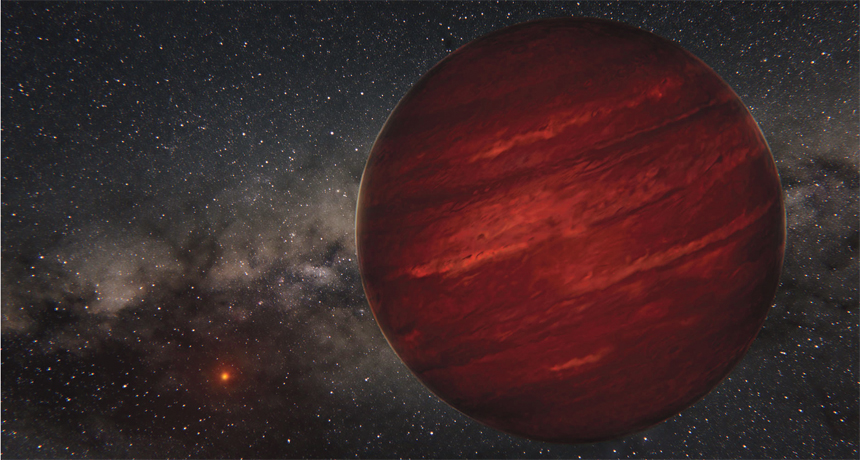Distant planet may boast the longest year
This ‘year’ is one for the record books

This is an artist’s idea of what the new giant planet orbiting GU Pisces A might look like.
Far from Earth, in the constellation Pisces, sits a red star known as GU Pisces A. Astronomers have just detected a planet orbiting this cool sun. But that planet likes to keep its distance from its parent. It orbits 2,000 times farther out from its host star than Earth does from our sun. It fact, this newfound exoplanet might just might have the longest planetary orbit known.
A year is defined as the time it takes a planet to complete one revolution around its star. One year for the new planet — known as GU Pisces “b” — lasts nearly 163,000 Earth years. That’s a very long time. For comparison, modern humans have walked the Earth for only about 200,000 years.
Astronomers spotted the planet’s heat signature in September 2011 as a speck of infrared light on a telescope image of stars nearly 156 light-years from Earth. Initially, the scientists thought it might be just another star. But as a series of images tracked that distant neighborhood of stars, most of those suns moved in slightly divergent directions. The little speck didn’t. It followed in seeming lock-step with GU Pisces A. And that suggested they could be a team: a distant solar system.
To be sure, Marie-Eve Naud of the University of Montreal, Canada, and her coworkers continued to track GU Pisces A for another two years using other telescopes and imaging tools. In the May 20 Astrophysical Journal, they now conclude the little speck accompanying it indeed is a planet circling that star at an enormous distance.
The planet glows, emitting infrared light, because it’s young — just 100 million years old — and still cooling. The escaping heat warms the planet to roughly 800º Celsius (1,470º Fahrenheit). Based on its age and brightness, astronomers estimate that the planet is nine to 13 times as massive as Jupiter.
Naud’s team says “it is unlikely that GU Pisces b was formed alone” at its current spot. If it formed as part of its sun’s system, then it probably started closer to its star. It could have gotten shoved to its distant orbit in response to some local interactions “with an unseen, more massive companion to GU Pisces A.” This would suggest that massive companion may be closer to the star than its planet is now. And the astronomers report they will now be looking to see if they can find such a hidden bully.
It’s also possible, the scientists say, that the planet could have formed elsewhere. At some point ejected from its birthplace, this orphan could have wandered as a “free-floating planet” until it was adopted by a new parent star: GU Pisces A.
Power Words
astronomy The area of science that deals with celestial objects, space and the physical universe as a whole. People who work in this field are called astronomers.
constellation Patterns formed by prominent stars that lie close to each other in the night sky. Modern astronomers divide the sky into 88 constellations, 12 of which (known as the zodiac) lie along the sun’s path through the sky over the course of a year. Cancri, the original Greek name for the constellation Cancer, is one of those 12 zodiac constellations.
exoplanet A planet that orbits a star outside our solar system.
light-year The distance light travels in a year, about 9.48 trillion kilometers (almost 6 trillion miles). To get some idea of this length, imagine a rope long enough to wrap around the Earth. It would be a little over 40,000 kilometers (24,900 miles) long. Lay it out straight. Now lay another 236 million more that are the same length, end-to-end, right after the first. The total distance they now span would equal one light-year.
orbit The curved path of a celestial object or spacecraft around a star, planet or moon. One complete circuit around a celestial body.
planet A celestial object that orbits a star, is big enough for gravity to have squashed it into a roundish ball and it must have cleared other objects out of the way in its orbital neighborhood. To accomplish the third feat, it must be big enough to pull neighboring objects into the planet itself or to sling-shot them around the planet and off into outer space. Astronomers of the International Astronomical Union (IAU) created this three-part scientific definition of a planet in August 2006 to determine Pluto’s status. Based on that definition, IAU ruled that Pluto did not qualify. The solar system now consists of eight planets: Mercury, Venus, Earth, Mars, Jupiter, Saturn, Uranus and Neptune.
star Thebasic building block from which galaxies are made. Stars develop when gravity compacts clouds of gas. When they become dense enough to sustain nuclear-fusion reactions, stars will emit light and sometimes other forms of electromagnetic radiation. The sun is our closest star.
telescope A light-collecting instrument that makes distant objects appear nearer through the use of lenses or a combination of curved mirrors and lenses. Some, however, collect radio emissions (energy from a different portion of the electromagnetic spectrum) through a network of antennas.







